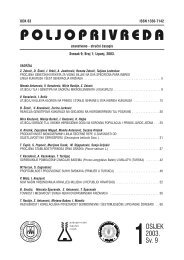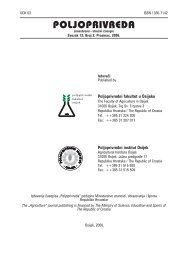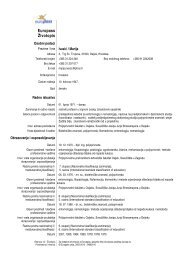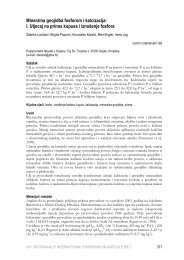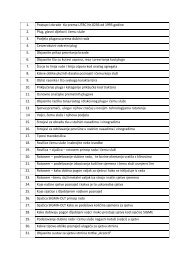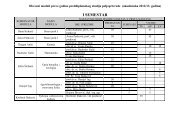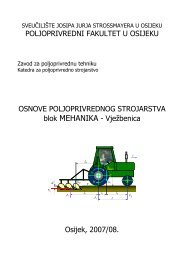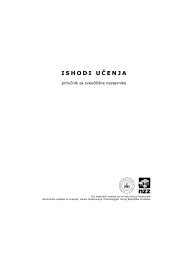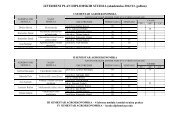1 THE GENERAL APICULTURAL SITUATION OF TURKEY ...
1 THE GENERAL APICULTURAL SITUATION OF TURKEY ...
1 THE GENERAL APICULTURAL SITUATION OF TURKEY ...
Create successful ePaper yourself
Turn your PDF publications into a flip-book with our unique Google optimized e-Paper software.
ISSN 1330-7142<br />
UDK = 638.1(560)<br />
<strong>THE</strong> <strong>GENERAL</strong> <strong>APICULTURAL</strong> <strong>SITUATION</strong> <strong>OF</strong> <strong>TURKEY</strong><br />
R. Sirali<br />
Scientific review<br />
Pregledni znanstveni članak<br />
SUMMARY<br />
This review is aimed to investigate the general structure, potential and their some important characteristics of<br />
Turkish beekeeping. Additional, the amount and type of beehives, important apicultural areas, honeybee<br />
products, bee races, migratory beekeeping, feeding technique, bee flora, disease and pests, main problems and<br />
some effected factors on apicultural yield were presented and their solutions suggested.<br />
Key-words: beekeeping, bee products, Turkey<br />
INTRODUCTION<br />
Beekeeping has been popular in Turkey, since the ancient times of Anatolian civilizations, Anatolian<br />
Turks Principalities, Seljuk’s and Ottoman States. Turkey has only a short history of beekeeping after<br />
the introduction of modern apiculture and the problems occuring from the environment in each area<br />
have not been identified and solved.<br />
Beekeeping sector has developed very fast after World War II in Turkey. Beekeeping is possible<br />
within the all seven geographical regions of Turkey. Climatic and environmental conditions are always<br />
very suitable to practice the art of bees rearing. Just now, about 4.3 million honeybee colonies there<br />
are supposed to be in Turkey.<br />
Today in our country, we have 40 000 professional beekeepers. Most of these beekeepers are teachers,<br />
farmers, retired, religious leaders or other jobs. Since, beekeeping is the most important income source<br />
over 200 000 families in Turkey.<br />
Even today the beekeepers in Turkey gain the experiences from their forefathers. But basically we do<br />
not have many professionals. Most of our beekeeping is supplementary to other activities done by<br />
people in rural areas.<br />
Unfortunately, Turkey has lagged behind other nations in the systematic use of honeybees to enhance<br />
pollination in order to improve crop yield and quality. The irony is that Anatolia region does have a<br />
very large bee industry focused on honey production. This honeybee potential is based on its<br />
utilization of many different Apis mellifera races and ecotypes, which are native to Anatolia and<br />
Thrace peninsulas.<br />
The aim of this present review was to investigate the general apicultural potential and some of their<br />
important characteristics of Turkish beekeeping.<br />
Important Apicultural Areas<br />
Every different region of Turkey has specific beekeeping and climatic condition, flora and<br />
management. Most of the beekeeping in Turkey takes place in Black Sea, Aegean, Eastern and Center<br />
Anatolian, Marmara and Southeastern Anatolia regions.<br />
Very important honey production districts in Turkey are high plateaus of Kars, Erzurum, Bitlis,<br />
Kayseri, Tunceli, Agri, Yozgat, Sirnak, Batman, Hakkari, Bingol, Van, Mus, Gumushane, Artvin,<br />
Giresun, Rize, Erzincan, Bayburt, Adiyaman, Malatya, Sivas cities, Cukurova, Harran, Ergene and<br />
________________<br />
Ph.D Redžep Sirali, Assistant Professor – Karadeniz Technical University, Ordu Agricultural Faculty,<br />
Department of Animal Science, 52100 Ordu, Turkey.<br />
1
Menderes plains, Karacadag, Anzer, Ovit, Sultanmurat, Alucra, Camoluk, Zigana, Sahara, Sarıbulut,<br />
Santa, Toros mountainous areas and northern area of Thrace.<br />
Most of the beekeeping in Turkey takes place in Mugla, Ordu, Adana, Izmir, Antalya, Aydin,<br />
Erzurum, Sivas, Konya, Kars, İcel and Ankara cities.<br />
Amount and Type of Bee Hives<br />
Turkey has great beekeeping potential of over 4.3 million beehives. Turkey, counting about five bee<br />
colonies per km 2 , is one of the countries with the highest density of beehives in the world (Table 1).<br />
Table 1. Number of colonies in Turkey<br />
Tablica 1. Broj košnica u Turskoj<br />
Year<br />
Godina<br />
1935 1095000 100.00 800 100.00 1895000 100.00<br />
1945 1000369 91.66 26489 3311.13 1026855 54.19<br />
1955 1167525 106.62 113529 14191.13 1281054 67.60<br />
1965 1320969 120.64 299487 37435.88 1620456 85.51<br />
1975 1054656 96.32 918628 114828.50 1973284 104.13<br />
1985 645142 58.92 1940161 242520.13 2585303 136.43<br />
1995 214594 19.60 3701444 462680.50 3916038 206.65<br />
1999 182266 16.65 4139430 517428.75 4321696 228.06<br />
Source: Statistical Indicators, State Statistical Institute of Turkey (DIE), Ankara, 2000<br />
Izvor: Statistički Pokazatelji, Državni statistički instıtut Turske (DIE), Ankara, 2000.<br />
The numbers of honeybee colonies in northern and western areas are larger than other regions of<br />
Turkey. Only about 14 percent of total beehives of Turkey are in Mugla city (Aegean region) and 8<br />
percentages in Ordu city (Black Sea region). Nearly half of our colony numbers are considered to be<br />
subject for migratory beekeeping.<br />
Most beekeepers have langstroth hives in Turkey. Only about 4.2% of total beehives are been still kept<br />
in traditional hives. Many beekeepers of Central Anatolian region generally use the cylindrical hives<br />
made from wood branches covered by mud. In the northern region of Anatolia, beekeepers use<br />
traditional log hives. Wood box hives are used in many districts of South-eastern Anatolia. The<br />
average quantity of collected honey is 2 to 5 kg per hive.<br />
In many districts of Marmara and Central Anatolian regions, some people deal with traditional<br />
beekeeping; they still use ancient styled beehives made of Salix ssp. branches covered by mud with<br />
straw and manure. They can get as many as 3-5 kg honey from a hive during the honey flow period.<br />
All traditional beehives are called Turkish “karakovan” or “sepetkovan” (primitive hive). As a result,<br />
honey yields of traditional beehives in Turkey are low generally. However, products of all these<br />
traditional hives are more expensive than modern bee hives.<br />
Bee Races<br />
Old type<br />
Stari tip<br />
Index<br />
Indeks<br />
1935=100<br />
Modern type<br />
Moderni tip<br />
Index<br />
Indeks<br />
1935=100<br />
Total<br />
Ukupno<br />
Index<br />
Indeks<br />
1935=100<br />
Turkey has many different kinds of topographic and climatic characteristics. As a result of this<br />
heterogeneous ecological structure, the honeybee has spread widely throughout Anatolia and Thrace,<br />
where it has differentiated into several forms. It is evident that there is much greater honeybee<br />
diversity in Turkey than in most other countries<br />
There are different bee races and ecotypes in Turkey, e.g. Apis mellifera caucasica (North east of<br />
Turkey), Apis mellifera anatoliaca (Central Anatolia) and their ecotypes such as Mugla, Gokceada<br />
Island, Marmara and Karadeniz. Each honeybee race and ecotype reflects in its morphology and<br />
behaviour environmental characteristics of its endemic range.<br />
The first important bee centre of Turkey is Central Anatolia. Apis mellifera anatoliaca bee, and well<br />
known as the Anatolian honeybee is the characteristic bee race of Anatolia. The honeybees of the<br />
2
Central Anatolia, with several subpopulations in the north, west and south, while Apis mellifera<br />
caucasica is considered as the honeybee of the mountain range bordering the northeast region of<br />
Anatolia. The most common ecotypes of Apis mellifera anatoliaca are the Mugla and the Central<br />
Anatolian bees.<br />
Apis mellifera anatoliaca is the most common bee in Turkey. They are very aggressive honeybees.<br />
They have many ecotypes adapted to different regions and showing great variation in terms of body<br />
colour, productivity, and specific morphological, physiological characters.<br />
Second important honeybee race of Turkey is Apis mellifera caucasica. The Caucasian bees are grey<br />
dark colored, gentle and productive bees with low swarming tendency and adapted to highlands and<br />
temperate climates. Therefore they collect much propolis, their spring development is slower than the<br />
other races but they build up strong colonies during the summer and produce much honey. They tend<br />
to rob the weak colonies.<br />
Same apicultural scientists considered that local honeybee of South-eastern Anatolia can be to Apis<br />
mellifera syriaca or Apis mellifera meda. General characters of honeybees in Southeastern Anatolian<br />
conditions are small colonies, relatively small quantity of honey storage, more aggressive than other<br />
honeybee races or ecotypes of Turkey, easily swarming. These characters are well fit to the fluctuating<br />
hot conditions to live, but not suitable for beekeeping sector.<br />
Nowadays, there are some different ideas about identifying the Thracian honeybees in Turkey. Some<br />
scientists describe Thracian bees as ecotypes of Apis mellifera anatoliaca or Apis mellifera carnica<br />
All these races and ecotypes are raw material for breeding studies. This genetic diversity represents the<br />
key element for Turkish scientist to lead the world in the development of crop-specific and taskspecific<br />
vector for the future.<br />
Bee Flora<br />
We produce flower honey mainly from cultivated plants, such as oranges (Mugla, İzmir, Antalya,<br />
Mersin, Adana, Hatay), cotton (Mardin, Diyarbakir, Sanliurfa, Gaziantep, Adana, Aydin, Nazilli,<br />
Izmir), sunflower (Istanbul, Tekirdag, Kirklareli, Edirne, Balikesir, Canakkale, Samsun, Aksaray,<br />
Yozgat, Adana), heather (Canakkale, Tekirdag, Kırklareli, İstanbul, Mersin, Tarsus ), chestnut<br />
(Trabzon, Giresun, Samsun, Rize, Sinop, Kastomonu, Bolu, Bursa, Canakkale, Balıkesir), linden trees<br />
(Tekirdag, Kırklareli, İstanbul ), as well as from different orchards. Wild Nectar yielding plants in the<br />
all regions of Turkey are clovers, acacia, raspberries, strawberry, bee balms etc.<br />
Our country has o lot of pollen yielding plants as almond trees (Amigdalus), Castanea sativa,<br />
Castanea vulgaris, Salix alba, Robinia pseudoacacia and Erica. Special importance goes to the last<br />
mentioned plant known by some honey lovers as a beaming health agent.<br />
Colonies foraging on forest plants, especially on Pinus trees (the Germans call the resulting honey<br />
“Waldhonig”), yield about 20% of our honey production. In this particular case, honey is being<br />
produced from honeydew of the insect Marchalina hellenica (Monophlebus hellenicus). Bee colonies<br />
are transported from all parts of the Turkish country to the lavish pine forests, found mainly on the<br />
Marmara’s islands (Büyükada and Heybeliada), on the peninsula of Aegean (Mugla, Fethiye, Denizli,<br />
Izmir, Edremit) and in Mediterranean region (Antalya). September and October are the most plentiful<br />
months.<br />
Significant amounts of honeydew honey derived from the Papaver, Carduus, Rosa, Tilia, Salix,<br />
Quercus, Castenea, Populus, Betula, Tamarix, Ulmus, Picea, Prunus, Pyrus and Malus<br />
Evident amounts of honeydew honey derived from the Abies trees in Marmara region and on the<br />
Uludag mountains situated about 500 km north east of Ankara and 300 km south of Istanbul. This<br />
honey is being produced from honeydew of the insect Lachnus ssp.<br />
Our world famous thyme honey, its renown, being due to its excellent flavour and richness in<br />
enzymes, constitutes a rather limited percentage of the annual honey production in Turkey. It comes<br />
from the Central Anatolia, Aegean, Black Sea and Marmara regions.<br />
Black Sea region is known the most popular and most precious variety of honey made by high plateau<br />
plants of Anzer. This product is more expensive than other honey districts of Turkey. It has specific<br />
colour, taste and strong elegant smell of Anzer high plateau plants. These plants only flowers at the<br />
end of June, beginning of August. So these bees have to make haste, being their unique opportunity to<br />
collect nectar.<br />
3
In addition, toxic honey (the Turks call the resulting honey “Deli bal=Crazy honey”, production<br />
derived in September and October from the Rhododendron ponticum that takes place in the northern<br />
mountains areas in Turkey. This area stretches from east to west parallel to the Black Sea and is<br />
bordered upon the east by the Central Anatolia.<br />
Migratory Beekeeping<br />
Migratory beekeeping style is very common and predominates in Turkey. This means that the hives<br />
have to be moved from one place to another searching for ultimate good quality honey in reasonable<br />
quantities.<br />
Migratory beekeeping, in which beekeepers move from north to south and from east to west following<br />
the blooming of honey plants, is not so popular at present because of the several reasons: aging of<br />
beekeepers, decreasing honey plants and large scale beekeepers.<br />
The honey bee colonies are transferred in spring to the citrus groves and thyme areas, in June to the fir<br />
forests, in summer to the cotton, clover and sunflowers plants and in August, September and October<br />
to the vast pine forests in the country generally.<br />
Professional beekeepers have about 100-400 bee colonies, sometimes up to 1000. They transport their<br />
hives extensively during the year; up to distances of 2000-4000 km. Eighty percentage of total<br />
migratory beekeepers of Turkey are from Ordu, a Black Sean city.<br />
As a consequence, the migratory beekeeping technique is improving. But, the genetic structure of the<br />
Turkish bee population is becoming homogenized and genetic variation is getting lost.<br />
Honeybee Products<br />
Although the main commodities are honey, beeswax, pollen, propolis, royal jelly, bee venom, queen<br />
and package, bees can also be produced from beekeeping activities.<br />
Beekeeping and its all products has important role in history of Turkish society and trade life. Thus<br />
almost all of bee products are useful to humans. Honey is the most important product of the<br />
beekeeping sector of Turkey. Seventy percentages of total honey production of Turkey is sold as comb<br />
and 30 percentages as extracted.<br />
According to the statistics of the State Statistical Institute of Turkey (DIE), honey production was<br />
67259 tons in 1999. Although the honey yield increases every year steadily, this increase is not<br />
satisfactory (Table 2). Turkey has only 5.7% of world honey product. One of the main reasons for the<br />
low honey yield is the insufficient queen bee production in the country.<br />
Table 2. Honey production in Turkey<br />
Tablica 2. Proizvodnja meda u Turskoj<br />
Years<br />
Godine<br />
Honey production (tons)<br />
Proizvodnja meda (t)<br />
Index<br />
Indeks<br />
1935=100<br />
Average production kg / hive<br />
Prosječna proizvodnja (kg/ košnici)<br />
Index<br />
Indeks<br />
1935=100<br />
1935 4338 100.00 2.29 100.00<br />
1945 3671 84.62 3.57 155.90<br />
1955 7111 163.92 5.55 242.36<br />
1965 10320 237.90 6.37 278.17<br />
1975 21250 489.86 10.77 470.31<br />
1985 35840 826.19 13.86 605.24<br />
1995 68620 1581.83 17.52 756.07<br />
1999 67259 1550.46 15.56 679.48<br />
Source: Statistical Indicators. State Statistical Institute of Turkey (DIE), Ankara, 2000<br />
Izvor: Statistički pokazatelij. Državni statistički instıtut Turske (DIE), Ankara, 2000.<br />
The annual honey production is estimated to be around 15.6 kg per colony, although values of about<br />
35-40 kg per colony are usual for professional beekeepers. Eighty percent of total honey of Turkey is<br />
produced by migratory beekeepers.<br />
4
While product quality usually differs among producers, there is general tendency of treating the<br />
products from the same areas as having the same quality. Generally, the marketability of products is<br />
mostly limited to the retail, domestic market and the international trade tends to be restricted of honey.<br />
Prices of all honeybee products are far the most important factor in competition; but capital investment<br />
is not so active in the beekeeping sector.<br />
Turkey’s pine honey production is very famous in the world. More than 90% of domestic production<br />
of pine honey was sold via exports, mostly those to European and Middle East countries every year.<br />
Exportation of honey of Turkey was nearly 5000 tons last years. This brought approximately $ 10<br />
million gain being the most important trade factor of our country. The value of honey export is<br />
variable every year (Table 3).<br />
Table 3. Honey Export of Turkey<br />
Tablica 3. Izvoz meda u Turskoj<br />
Year<br />
Godina<br />
Honey export (tons)<br />
Izvoz meda (t)<br />
Index<br />
Indeks<br />
1936=100<br />
Export value (1000 $)<br />
Izvozna vrijednost (1000 $)<br />
Index<br />
Indeks<br />
1963=100<br />
1963 4 100.00 3 100.00<br />
1965 2 50.00 1 33.33<br />
1975 54 1350.00 69 2300.00<br />
1985 2176 54400.00 4050 135000.00<br />
1995 2934 73350.00 6759 225300.00<br />
1999 5306 132650.00 9996 333200.00<br />
Source: Honey Export of Turkey. www. fao.org.<br />
Izvor: Izvoz meda Turske. www. fao.org.<br />
The domestic output of beeswax is about 4073 tons. According to the statistics of the State Statistical<br />
Institute of Turkey (DIE), the wax production of the different years is given in Table 4.<br />
Table 4. Wax production in Turkey<br />
Tablica 4. Proizvodnja voska u Turskoj<br />
Years<br />
Godine<br />
Wax production (tons)<br />
Proizvodnja vosak (ton)<br />
Index<br />
Indeks<br />
1936=100<br />
Average production kg / hive<br />
Prosječna proizvodnja kg/ košnici<br />
Index<br />
Indeks<br />
1936=100<br />
1935 602 100.00 0.32 100.00<br />
1945 412 68.44 0.40 125.00<br />
1955 844 140.20 0.66 206.25<br />
1965 1.144 190.03 0.71 221.88<br />
1975 1.712 284.39 0.87 271.88<br />
1985 2.196 364.78 0.85 265.63<br />
1995 3.735 620.43 0.95 296.88<br />
1999 4.073 675.58 0.94 293.75<br />
Source: Statistical Indicators. State Statistical Institute of Turkey (DIE), Ankara, 2000<br />
Izvor: Statistički pokazatelij. Državni statistički instıtut Turske (DIE), Ankara, 2000.<br />
The DIE statistics show that about 4073 tons of wax were produced in Turkey and it can be supposed<br />
that almost all of the raw materials were sold on the market used for honey comb production.<br />
Other bee products of Turkey (pollen, royal jelly, bee venom and propolis) have important role in our<br />
beekeeping industry. Trading amount of honeybee colonies of Turkey are nearly 40000-50000 units<br />
annually.<br />
According to the annually statistics of the ministry of Agriculture of Turkey, the value of honey<br />
production was $ 150 million, producing queens and bees for sale to other beekeepers $ 36 million and<br />
other bee products (pollen, propolis and royal jelly) $ 2.9 million in 1999.<br />
Moreover, bees pollinate the flowering plants while collecting nectar and pollen thus increase the<br />
quality and quantity of cultivated crop plants enabling the wild flowers and many plants to survive.<br />
5
In Turkey, the added value in agriculture from honeybee pollination is over $ 2.3 billion annually,<br />
however, beekeepers do not earn extra income from transport of their colonies for pollination.<br />
Diseases and Pests<br />
Some well-known diseases and pests, such as the Varroa mite and chalk brood as well as the abundant<br />
use of pesticides in agriculture and frequent fires in the woods, cause serious problems to our<br />
beekeepers.<br />
The Varroa mite was first recorded in Turkey in 1976, close to the Bulgarian and Greek Borders in<br />
Thrace, and from Russian border to the Northeastern Anatolia in 1980. Shortly afterwards, late that<br />
same year, the dangerous mite was found in some other areas like Marmara, Central Anatolia, Eastern<br />
Anatolia, Black Sean, Aegean and Mediterranean regions.<br />
There is a slight decline in the infection rate of chalk brood (Ascosphaera apis) but it can be endemic<br />
again any time as happened to be in other countries.<br />
The chalk brood disease is the other important problem of Turkish beekeeping, too. This disease was<br />
first recorded in 1986 in Turkey. Nowadays the diseases and pests can be found in beehives all over<br />
the country. Because of this, it is hard to increase the number of beehives.<br />
Transfer of the beehives to other places spread the parasites and gave serious damage in the new area,<br />
in Turkey after 1980. In addition, migratory beekeeping practise can be considered as having been the<br />
main course of the present dramatic Varroa mite and chalk brood situation in Turkey.<br />
We have no accurate official data on the losses of colonies, except for the period 1978-1988.<br />
According to the Turkish beekeepers, it is estimated that 20-30% of the colonies were severely<br />
damaged or totally destroyed by the Varroa and chalk brood.<br />
Similarly, the spread of American foulbrood (Paenibacillus larvae) and nosematosis (Nosema apis)<br />
are increasing countrywide. Other important diseases and pests of Turkey are nosema, foulbrood, wax<br />
moths, tracheal mites and wasp. All these diseases and pests lower the population growth of the bees,<br />
weaken the colonies and decrease the production of honey and other bee products.<br />
Beekeepers use many pesticides. Thus, Varroatosis is now under control by using effective acaricides<br />
against it. Active ingredients of this effective acaricides are Caumaphos, Asuntal, Flumethrin,<br />
Amitraz, Malathion, Bromopropylat, Cymiazol, Fluvalinate, Formic Acid and others. However vast<br />
and overdose use of these pesticides, effectiveness of these chemicals decreased, mites become<br />
resistant to these pesticides in the colonies and residue become a major problem due to inappropriate<br />
or misuse of these chemicals. Moreover, the bees became more susceptible to the bacterial viral and<br />
fungal diseases due to Varroa infections. Up to now, no registered drug exists in Turkey against chalk<br />
brood.<br />
Application of some chemicals (antibiotics, pesticides etc.) sometimes causes the residue problems<br />
affecting the quality of some hive products. Extension education of beekeepers about the application<br />
of the chemicals is poor. For this reason it cannot be controlled in general.<br />
Feeding Method<br />
Generally government controls sugar prices being lower than that of honey. Because of this, bees can<br />
be fed enough sugar syrup and are not liable to cause robbing. This situation may not result in the<br />
spread of diseases and harmful mites. Keeping bees requires the feeding them sugar syrup to promote<br />
the building up of colonies or to keep them healthy during the season when resources are scarce.<br />
Bees in central, northern and eastern areas spend five to six winter months without hibernation and<br />
thus need large quantities of honey. The amount of honey stored by Turkish bees differs according to<br />
the size of their colonies but should be at least 5 to 20 kg at the time when they start hibernation.<br />
Main Problems of Beekeeping in Turkey<br />
Turkish beekeeping face the same problems as anywhere else in the world. Our beekeeping has a<br />
variety of problems to be dealt with. Among them we can say the main problems are: the biological<br />
6
problems of bees, climate and other natural features, relations to environmental factors, beekeeping<br />
techniques, the quality of products and problems in marketing and trading.<br />
There are several problems such as existence of honeybee diseases and pests, keeping old and<br />
unproductive queens in colonies, apicultural equipments and supplies, education of beekeepers,<br />
nutrition and management, disease and pests, lack of knowledge of beekeepers in many aspects of<br />
beekeeping and lack of organisation among the beekeepers.<br />
In order to solve these problems, a queen bee production centre should be established, beekeepers<br />
should be trained on the diagnosis and treatment of honeybee diseases and technical beekeeping. Also,<br />
they should be encouraged to have beekeeping organisations such as associations or cooperatives. As a<br />
result, some measures should be taken to promote this re-education of beekeepers.<br />
Retraining beekeepers is important for product quality improvement and better distribution as well as<br />
for better beekeeping technology development.<br />
CONCLUSION<br />
Turkey has great beekeeping potential having very rich flora and suitable ecology that unfortunately<br />
has not been utilised properly. Total honey production, honey yield and production of other bee<br />
products are rather low and it is possible to increase them twice or thrice. Some of the reasons for low<br />
yield are the widespread of bee diseases and parasites, insufficient queen production, educational level<br />
and knowledge of beekeepers, as well as lack of beekeeping organisations.<br />
REFERENCES<br />
1. Anonymous (1986): Aricilik. Ana Britannica. İstanbul, 274-275.<br />
2. Cakmak, I. (1999): Honeybees and Agriculture. May Agro-Tek. Bursa, 3(7): 7-9.<br />
3. Darendelioglu, Y., Kence, A. (1992): Morphometric Study on Population Structure of Middle<br />
Anatolia Honey Bee (Apis mellifera L.) (Hymenoptera, Apidae). The Second Turkish National<br />
Congress of Entomolgy. Adana, 387-396.<br />
4. Delaplane, K.S. (1999): Honey Bees and Beekeeping. The University of Georgia, College of<br />
Agricultural and Environmental Sciences, Athens, Georgia.<br />
5. Genc, F. (1993): Ariciligin Temel Esaslari. Atatürk Universitesi Ziraat Fakultesi Yayin, No. 149,<br />
Erzurum, 138–185.<br />
6. Güler, A., Korkmaz, A., Kaftanoğlu, O. (1999): Reproductive Characteristics of Turkish<br />
Honeybee (Apis mellifera L.) Genotypes. Hayvansal Uretim. Izmir. 39-40: 113-119.<br />
7. Infandites, M. (1990): Beekeeping in Greece. Bienenstich, No 17, Ciba-Geigy AG, Basel.<br />
8. Kaftanoglu, O. (1998): National Beekeeping Development Project. Cukurova University,<br />
Agricultural Faculty, Department of Animal Sciences, Adana.<br />
9. Kaftanoglu, O. (2001): The Concept of Honey Bee Races and Race Preference. Uludag Bee<br />
Journal. Bursa, 1(3):11-20.<br />
10. Nakamura, J. (1999): Problems of Beekeeping in Asia. Farming Japan, Vol. 33-3, 15-17.<br />
11. Sahinler, N., Sahinler, S. (1996): A Study on the Present Situation and Problems of Apiculture and<br />
Some Recommendation in Hatay Province. Journal of Agricultural Faculty of Mustafa Kemal<br />
University, 1(1):17-28.<br />
12. Santas, L.A. (1990): The dangerous mite plagues Grecien bees, Varroa spread rapidly.<br />
Bienenstich, No 17, Ciba-Geigy AG, Basel.<br />
13. Sasaki, M. (1999): Ecological Characteristics of Asiatic Hive Bee and its possibility as Apicultural<br />
Species. Farming Japan, Vol. 33-3, 18-22.<br />
OPĆA PČELARSKA SITUACIJA U TURSKOJ<br />
SAŽETAK<br />
U ovom radu istražuje se opća struktura, potencijali i neke važne značajke turskog pčelarstva. Prikazani su<br />
broj i tipovi košnica, važne pčelarske regije, pčelarski proizvodi, pasmine pčela, selidbeno pčelarstvo, tehnika<br />
7
hranjenja, medonosno bilje, bolesti i nametnici pčela, glavni problemi u pčelarskoj proizvodnji, neki<br />
čimbenici koji utječu na prinos u pčelarstvu te prijedlozi mjera za njihovo rješavanje.<br />
Ključne riječi: pčelarstvo, pčelinji proizvodi, Turska<br />
(Received on 14 March 2002; accepted on 9 July 2002 – Primljeno 14. ožujka 2002.; prihvaćeno 9. srpnja<br />
2002.)<br />
8



